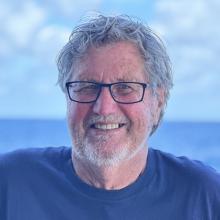
Chris Gaskin
Tell us about your work/ research. What kinds of things do you do?
Have over 20 years’ experience working with seabirds, specialising in at sea research, and project managing for seabird/island surveys/research expeditions for northern New Zealand (including Kermadec Island Islands) and the South Pacific. From 2013 to 2015 was the project coordinator for Important Bird and Biodiversity Area (IBA) Programme (NZ seabirds) BirdLife International (through Forest & Bird, BirdLife’s New Zealand partner). Special areas of research include seabirds of the South Pacific Ocean; pioneering and developing at-sea capture methods of Procellariforms which led to the discovery of the NZ storm petrel breeding on Te Hauturu-o-Toi (Little Barrier Island). since been applied to the discovery of a new species, Pincoya Storm Petrel, Chile; first tracking of a highly threatened species, Beck’s Petrel, Papua New Guinea; study of the ecology of the White-vented Storm Petrel, Galapagos, Ecuador (soon to be elevated to full species status); Balearic Shearwaters in France, two years for tracking and physiological research in relation to Offshore Wind Farm development; the first at-sea captures of Black-capped Petrel, Gulf Stream waters, USA; and most recently Black Petrels in New Zealand for a mark recapture and population study. Since 2016, I have been lead-investigator in a series of contracts with the New Zealand Department of Conservation (DOC), Conservation Services Programme (CSP) investigating the feeding associations of seabirds (fish schools, cetaceans), population trends, indirect effects from fisheries, and the study of the effects of light attraction on seabirds. A strong advocate for seabirds, I am the instigator of several initiatives promoting public awareness of seabirds and the threats they face. In 2021, I drafted a seabird action plan (with BirdLife International) for the South Pacific Regional Environment Programme (SPREP) and (with colleagues) has led the preparation of a comprehensive survey and monitoring manual for Pacific seabirds. I am a trustee for the Northern NZ Seabird Trust, a research and conservation NGO I helped establish. I am also the Australasian Regional Representative (includes Oceania) on the Board of Directors for the World Seabird Union.
What sparked your initial interest in your career?
Formerly a wildlife artist and illustrator of natural history publications, including children's books, so always interested in the natural world. For several years ran a bird watching company (with my wife) and specialised in seabird birdwatching trips at sea. Through that work identified significant gaps in our knowledge of seabirds in New Zealand, and became more involved in island surveys, recording seabird sightings at sea, which in turn led to establishing an NGO (Northern NZ Seabird Trust), to facilitate and contract for seabird research and conservation projects.
Who influenced you or encouraged you the most?
Initially my parents for the of love of observing and recording nature, and a love for the sea. Since then, I have enjoyed collaborating (as an artist) with scientists, including paleontologists (reconstructing fossil marine fauna) and archaeologists (reconstructing prehistoric and historic sites), and more recently with marine scientists.
What element of your work/ study do you think is the most fascinating?
I jokingly say I'm something of a 'gun for hire' (in the nicest possible sense) through pioneering and developing at-sea capture methods of Procellariforms (petrels, shearwaters and storm-petrels), work which has taken me to a number of places around the world. Next year I will back be working in the Gulf Stream off Cape Hatteras with a team from South Carolina (Clemson University) capturing endangered Black-capped Petrels for a tracking project.
How did you get involved with Ocean Exploration Trust? How did you become part of the expedition team?
Through a NOAA webinar which featured the OET Chief Scientist and made contact after learning about forthcoming Pacific voyages. Both my wife (Karen Baird) and myself are currently based in Samoa.
What other jobs led you to your current career?
As above, wildlife and natural history artist and illustrator; also exhibit and interpretative designer for museums, visitor centres and for publications; running bird watching tours throughout Aotearoa New Zealand; Project Coordinator for the Northern NZ Seabird Trust (nine years); independent consultant (seabirds).
What are your hobbies?
I love the sea; I still produce artwork; enjoy planting trees and gardening; rowing my wooden clinker dinghy on the harbour when back at home in NZ.
What advice would you give someone who wants to have a career like yours?
An aspect of setting up and running the Northern NZ Seabird Trust has been to mentor and support a number of students (PHD and Masters degree), especially through fieldwork on offshore islands or at sea. Key to the success of this has been encouraging them to work collaboratively, helping each other across their various disciplines, working together in the field. One piece of advice I like to give is that "networking is key", reach out, make contact, broaden your horizons.
What excites me most is opportunity a mission like this offers in terms of new discoveries; as well as working with a team of talented people working across multiple disciplines.
Expeditions
Chris participated in the following Ocean Exploration Trust expeditions:


